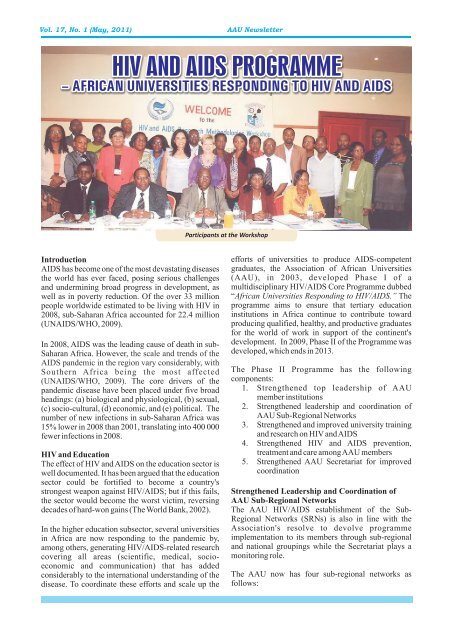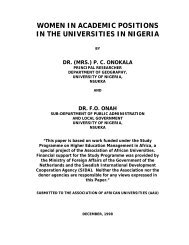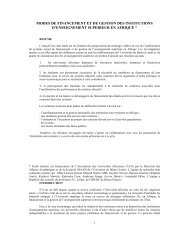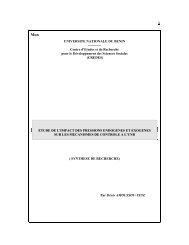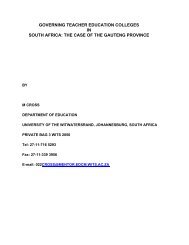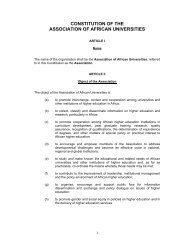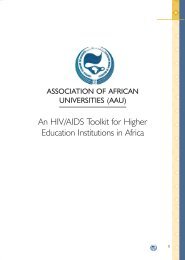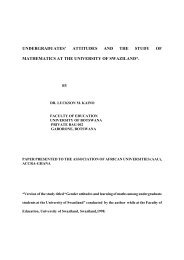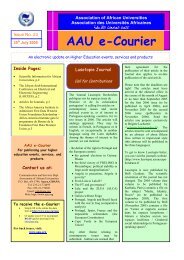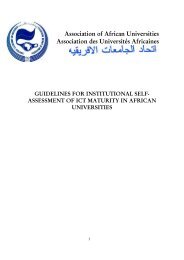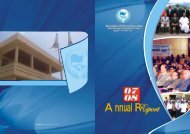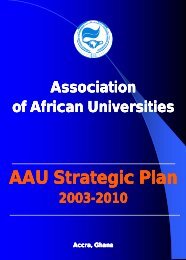AAU NEWSLETTER English Vol. 17 Issue 1 2011 - AAU Resource ...
AAU NEWSLETTER English Vol. 17 Issue 1 2011 - AAU Resource ...
AAU NEWSLETTER English Vol. 17 Issue 1 2011 - AAU Resource ...
- No tags were found...
Create successful ePaper yourself
Turn your PDF publications into a flip-book with our unique Google optimized e-Paper software.
<strong>Vol</strong>. <strong>17</strong>, No. 1 (May, <strong>2011</strong>) <strong>AAU</strong> NewsletterHIV AND AIDS PROGRAMME– AFRICAN UNIVERSITIES RESPONDING TO HIV AND AIDSParticipants at the WorkshopIntroductionAIDS has become one of the most devastating diseasesthe world has ever faced, posing serious challengesand undermining broad progress in development, aswell as in poverty reduction. Of the over 33 millionpeople worldwide estimated to be living with HIV in2008, sub-Saharan Africa accounted for 22.4 million(UNAIDS/WHO, 2009).In 2008, AIDS was the leading cause of death in sub-Saharan Africa. However, the scale and trends of theAIDS pandemic in the region vary considerably, withSouthern Africa being the most affected(UNAIDS/WHO, 2009). The core drivers of thepandemic disease have been placed under five broadheadings: (a) biological and physiological, (b) sexual,(c) socio-cultural, (d) economic, and (e) political. Thenumber of new infections in sub-Saharan Africa was15% lower in 2008 than 2001, translating into 400 000fewer infections in 2008.HIV and EducationThe effect of HIV and AIDS on the education sector iswell documented. It has been argued that the educationsector could be fortified to become a country'sstrongest weapon against HIV/AIDS; but if this fails,the sector would become the worst victim, reversingdecades of hard-won gains (The World Bank, 2002).In the higher education subsector, several universitiesin Africa are now responding to the pandemic by,among others, generating HIV/AIDS-related researchcovering all areas (scientific, medical, socioeconomicand communication) that has addedconsiderably to the international understanding of thedisease. To coordinate these efforts and scale up theefforts of universities to produce AIDS-competentgraduates, the Association of African Universities(<strong>AAU</strong>), in 2003, developed Phase I of amultidisciplinary HIV/AIDS Core Programme dubbed“African Universities Responding to HIV/AIDS.” Theprogramme aims to ensure that tertiary educationinstitutions in Africa continue to contribute towardproducing qualified, healthy, and productive graduatesfor the world of work in support of the continent'sdevelopment. In 2009, Phase II of the Programme wasdeveloped, which ends in 2013.The Phase II Programme has the followingcomponents:1. Strengthened top leadership of <strong>AAU</strong>member institutions2. Strengthened leadership and coordination of<strong>AAU</strong> Sub-Regional Networks3. Strengthened and improved university trainingand research on HIV and AIDS4. Strengthened HIV and AIDS prevention,treatment and care among <strong>AAU</strong> members5. Strengthened <strong>AAU</strong> Secretariat for improvedcoordinationStrengthened Leadership and Coordination of<strong>AAU</strong> Sub-Regional NetworksThe <strong>AAU</strong> HIV/AIDS establishment of the Sub-Regional Networks (SRNs) is also in line with theAssociation's resolve to devolve programmeimplementation to its members through sub-regionaland national groupings while the Secretariat plays amonitoring role.The <strong>AAU</strong> now has four sub-regional networks asfollows:


